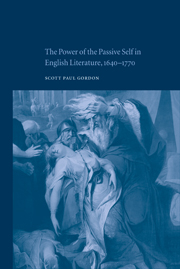Book contents
- Frontmatter
- Contents
- Acknowledgments
- Introduction. “Spring and Motive of our Actions”: disinterest and self-interest
- 1 “Acted by Another”: agency and action in early modern England
- 2 “The belief of the people”: Thomas Hobbes and the battle over the heroic
- 3 “For want of some heedfull Eye”: Mr. Spectator and the power of spectacle
- 4 “For its own sake”: virtue and agency in early eighteenth-century England
- 5 “Not perform'd at all”: managing Garrick's body in eighteenth-century England
- 6 “I wrote my Heart”: Richardson's Clarissa and the tactics of sentiment
- Epilogue: “A sign of so noble a passion”: the politics of disinterested selves
- Notes
- Bibliography
- Index
Epilogue: “A sign of so noble a passion”: the politics of disinterested selves
Published online by Cambridge University Press: 22 September 2009
- Frontmatter
- Contents
- Acknowledgments
- Introduction. “Spring and Motive of our Actions”: disinterest and self-interest
- 1 “Acted by Another”: agency and action in early modern England
- 2 “The belief of the people”: Thomas Hobbes and the battle over the heroic
- 3 “For want of some heedfull Eye”: Mr. Spectator and the power of spectacle
- 4 “For its own sake”: virtue and agency in early eighteenth-century England
- 5 “Not perform'd at all”: managing Garrick's body in eighteenth-century England
- 6 “I wrote my Heart”: Richardson's Clarissa and the tactics of sentiment
- Epilogue: “A sign of so noble a passion”: the politics of disinterested selves
- Notes
- Bibliography
- Index
Summary
Are there objects in mid-century England more complex than tears? Literary texts often display the capacity to fake tears, using this practice (as we have seen) to mark sinister characters. Virtuous characters in Tom Jones (1749) do shed “tender Tears,” but Blifil fakes them (wiping away non-existent tears, not producing false ones) and Mrs. Honour produces them at will: “[S]he found Sophia standing motionless, with the Tears trickling from her Eyes. Upon which [Mrs. Honour] immediately ordered a proper quantity of Tears into her own Eyes.” Nor is this practice evident only in novels. Refusing to be moved by speeches delivered “with weeping eyes,” Cromwell's enemies insist that “he hath teares at will, & can dispense with any Oath or Protestation without troubling his conscience.” A hundred years later the capacity to manipulate tears no longer signals such serious faults (oath-breaking, lack of conscience), but it remains a troubling phenomenon. When in 1779 Hester Thrale coaxed Sophy Streatfield to prove that “she had Tears at command,” Frances Burney watched Streatfield make “Tears come into her Eyes, & [roll] down her fine Cheeks” and then “ran away”: “When I saw real Tears, I was shocked.” Four months later Thrale demands a repeat performance (“Lord, she shall Cry again if you like it”) and Burney records that “two Crystal Tears came into the soft eyes of the S. S., – and rolled gently down her Cheeks! – such a sight I never saw before, nor could I have believed.… indeed, she was smiling all the Time.”
- Type
- Chapter
- Information
- The Power of the Passive Self in English Literature, 1640–1770 , pp. 212 - 214Publisher: Cambridge University PressPrint publication year: 2002



